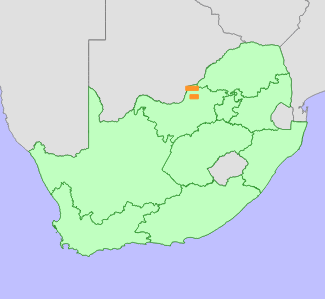|
Scientific Name | Euphorbia knobelii Letty |
Higher Classification | Dicotyledons |
Family | EUPHORBIACEAE |
Synonyms | Euphorbia perangusta R.A.Dyer |
National Status |
Status and Criteria | Endangered A2ace; B1ab(iii,v)+2ab(iii,v) |
Assessment Date | 2016/09/27 |
Assessor(s) | R.H. Archer, L. von Staden, J.E. Victor & N. Hahn |
Justification | A population reduction of 50-60% is estimated based on field observations over a period of 30 years (less than three generations). Plants remain at two to five locations within a restricted area (EOO 1277 km²), and continue to decline due to habitat degradation and disease. |
Distribution |
Endemism | South African endemic |
Provincial distribution | North West |
Range | Marico district north of Zeerust. |
Habitat and Ecology |
Major system | Terrestrial |
Major habitats | Dwarsberg-Swartruggens Mountain Bushveld |
Description | Woodland and thornveld, wedged among large rocks on the slopes of quartzitic ridges, 1000-1200 m. |
Threats |
| Illegal collection of wild plants has severely reduced the subpopulations at the type localities for both E. perangusta and E. knobelii, leading to the local extinction of the subpopulation at the type locality for E. knobelii. The most severe threat that is impacting subpopulations across the range is severe habitat degradation and trampling by livestock. Plants are not browsed, but stems are damaged by trampling making plants more susceptible to disease and fungal infections, and is drastically reducing the ability of mature individuals to reproduce. Severe droughts in the 1980s and early 1990s may also have marred the ability of the population to recover from disease-related die-off (Hahn 2013). During drought years, porcupines have been noted to feed on subpopulations of E. perangusta, destroying large proportions of already very small subpopulations. Poor recruitment is a cause for concern, most plants are old and no seedlings was noted during monitoring in the 1980s (Raal 1988). |
Population |
The population of E. knobelii/perangusta was monitored as part of a plant conservation programme in the 1980s. Surveys of the habitat recorded 253 plants in five subpopulations, with the largest subpopulation consisting of 128 plants, the others between 4 and 50 mature individuals (Raal 1988). The largest subpopulation declined to between 30-40 mature individuals by 1998 (Peckover 1999), and the total population was estimated to be less than 100 mature individuals in 1998 (Peckover 1999). Significant declines were also observed at the type locality of E. knobelii, where there were less than 10 plants remaining by 2008 (A. Barac pers. comm. 2008), and no plants could be found there in 2011 (Hahn 2013).
Follow-up surveys in 2011 found the southernmost subpopulations to be stable. Four additional subpopulations found in the area however showed severe die-off and were all on the brink of extinction (Hahn 2013). Based on monitoring data, a population reduction of 50-60% is estimated within the past three generations (generation length 10-20 years). Ongoing monitoring is needed to determine the long-term effects of drought and parasites on the dynamics of the wild population (Hahn 2013).
|
Population trend | Decreasing |
Notes |
| This assessment includes plants described under the name Euphorbia perangusta R.A.Dyer. E. perangusta overlaps in range with E. knobelii and is insufficiently distinct from E. knobelii to warrant recognition as a separate taxon (R.H. Archer pers. comm. 2008). |
Assessment History |
Taxon assessed |
Status and Criteria |
Citation/Red List version | | Euphorbia knobelii Letty | EN A2ace; B1ab(iii,v)+2ab(iii,v) | 2017.1 | | Euphorbia knobelii Letty | Data Deficient (Taxonomically Problematic) | Raimondo et al. (2009) | | Euphorbia knobelii Letty | Rare | Hilton-Taylor (1996) | | Euphorbia knobelii Letty | Endangered | Hall et al. (1980) | |
Bibliography |
Fourie, S.P. 1987. An introduction to the succulent Euphorbias of the Transvaal. Part two: Shrubs. The Euphorbia Journal 4:48-68.
Hahn, N. 2013. Rare, endangered and endemic flora of the North West Province. Unpublished Report to the Department of Economic Development, Conservation and Tourism, North West Provincial Government.
Hall, A.V., De Winter, M., De Winter, B. and Van Oosterhout, S.A.M. 1980. Threatened plants of southern Africa. South African National Scienctific Programmes Report 45. CSIR, Pretoria.
Hilton-Taylor, C. 1996. Red data list of southern African plants. Strelitzia 4. South African National Botanical Institute, Pretoria.
Letty, C. 1934. Euphorbia knobelii. Flowering plants of South Africa 14:t. 521.
Peckover, R.G. 1999. Euphorbia perangusta on the brink of extinction: Can we help? Veld & Flora 85(4):170-171.
Raal, P.A. 1988. Ecology and population biology of Euphorbia perangusta (Euphorbiaceae) in the Transvaal, South Africa. Bothalia 18(1):105-110.
Raimondo, D., von Staden, L., Foden, W., Victor, J.E., Helme, N.A., Turner, R.C., Kamundi, D.A. and Manyama, P.A. 2009. Red List of South African Plants. Strelitzia 25. South African National Biodiversity Institute, Pretoria.
White, A., Dyer, R.A. and Sloane, B.L. 1941. The succulent Euphorbieae (Southern Africa) Volume I. Abbey Garden Press, Pasadena.
|
Citation |
| Archer, R.H., von Staden, L., Victor, J.E. & Hahn, N. 2016. Euphorbia knobelii Letty. National Assessment: Red List of South African Plants version 2024.1. Accessed on 2025/12/07 |
 Comment on this assessment
Comment on this assessment


